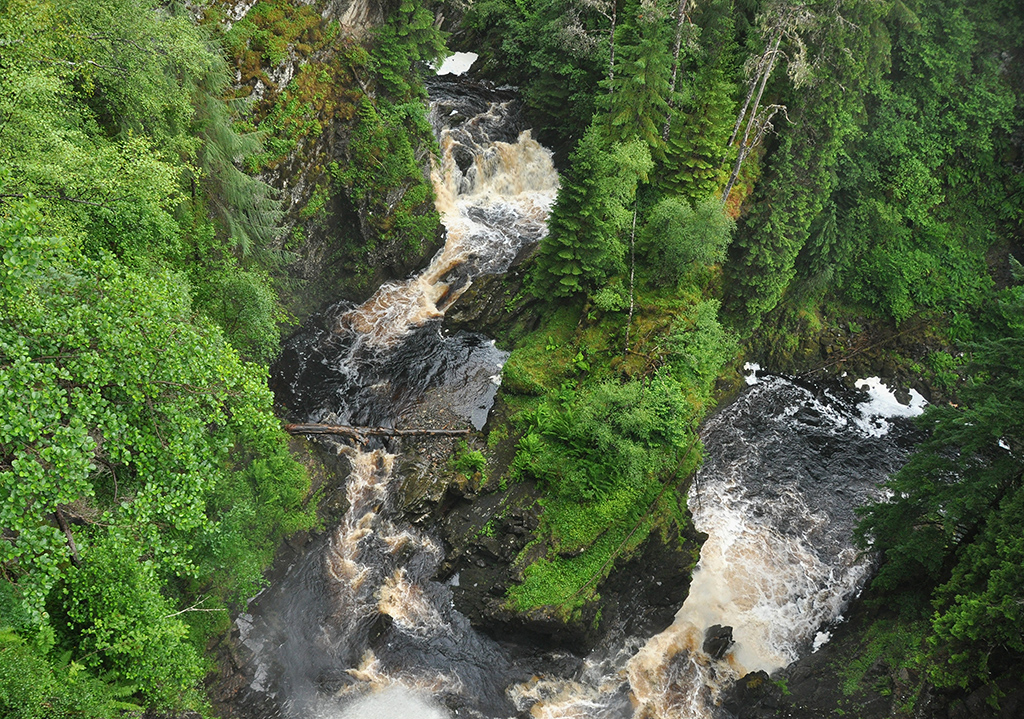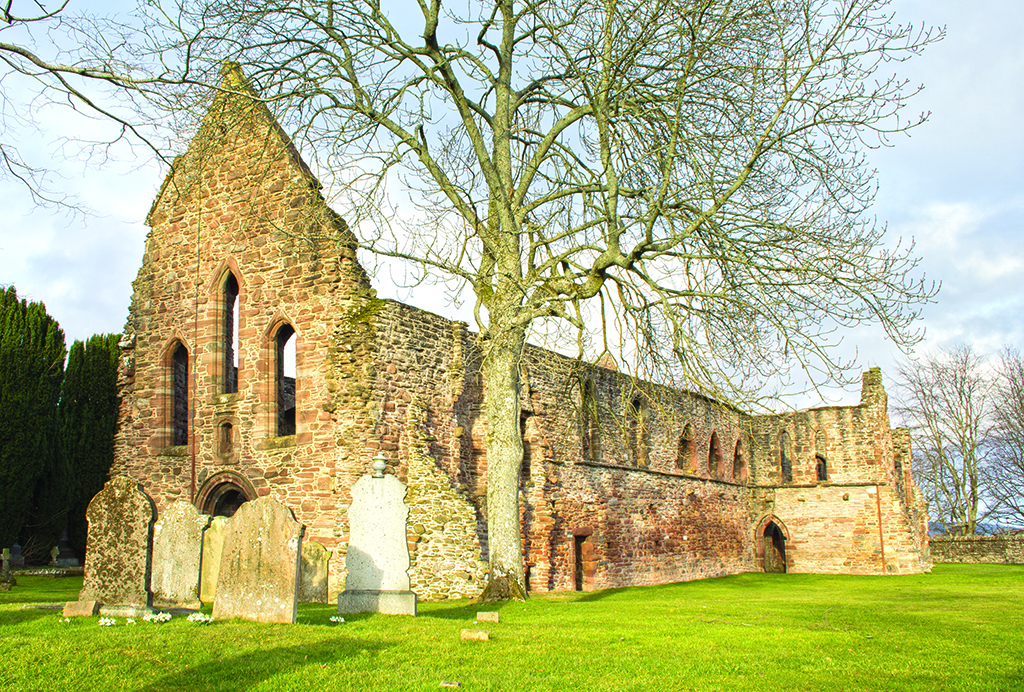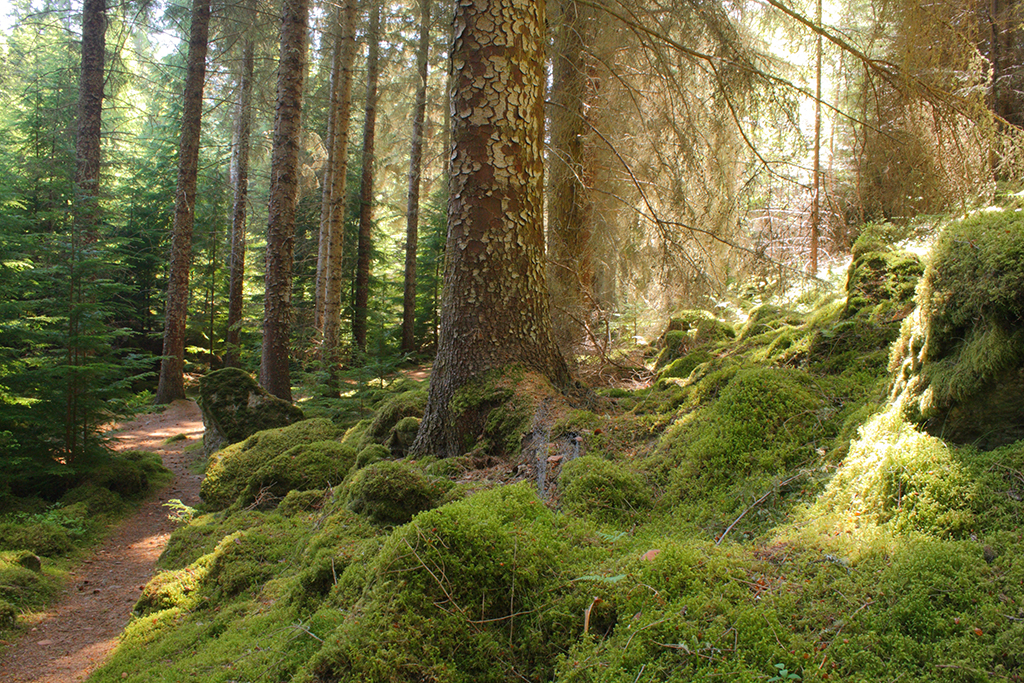
Scotland’s natural wonder with a colourful past
The beauty of Beauly and Strathglass first attracted the attentions of royalty and high society centuries ago – and it still continues to dazzle visitors today.
Believed to have been founded in the 13th century by John Byset, Lord of the Aird, for Valliscaulian monks, the Beauly Priory is now a ruin.
The roofless red sandstone narthex and nave of the priory’s church is flanked by an arcade of windows, the ground paved with Celtic gravestones. Great oak and sycamore trees in the cemetery give clues to the age of this historic site.
Remnants of the adjoining monastery lie to the east, though much of the stone was stolen to build Cromwell’s fort in Inverness in 1563.
It is said that when Mary, Queen of Scots travelled through the Highlands to Easter Ross in the summer of 1564 she stayed a night at the Beauly Priory. Touched by its beauty, she is reputed to have said: ‘Oui, c’est un beau lieu’ (Yes, it is a beautiful place), the name the village has enjoyed ever since.
After the reformation in Scotland, James VI awarded the land to Lord Lovat, Chief of Clan Fraser and laird of the Barony of Lovat.
Today the village is home to the internationally celebrated tailor and tweed house, Campbell’s of Beauly, established in 1858. Campbell’s has historically held Royal Warrants for both HRH The Prince of Wales and Her Majesty Queen Elizabeth the Queen Mother.

Plodda Falls, reputedly one of the highest vertical falls in Scotland, plunges 46 metres into Glen Affric
The previous owners kept a very strict lunch break and it is rumoured that they once made the King of Spain wait outside until exactly 2pm for the shop to reopen. Opposite Campbell’s is Iain Marr Antiques, the Highlands’ only antique shop specialising in Scottish silver.
At one time the Lovat Estate stretched from the east to the west coast of Scotland, encompassing a large part of the Highlands. One of the most beguiling and villainous of the Lovat Chiefs, known as Simon The Fox for his habitual deviousness, was head of the Clan during the 1745 rebellion.
Like most Highland chiefs he was a Jacobite, but sought to hedge his bets at the Battle of Culloden so that he could claim to have backed the winning side whoever was victorious. He sent men to fight with the Hanoverian troops while declaring his allegiance to the Bonnie Prince.
After the catastrophic Jacobite defeat his treachery was revealed and Lovat became the last peer to be beheaded in England as an example to other Jacobite chiefs.
Eskadale Church cemetery is the resting place for one of Scottish history’s most notorious imposters. The handsome and well-mannered charlatan brothers John and Charles Allen were keen hunters who possessed a scholarly knowledge of Scottish history, speaking many languages fluently, including Gaelic.
After moving to Edinburgh in 1823, the pair Scoticised their names and became John Hay Allan and Charles Stuart Allan, allowed by a distant link with the Earls of Errol, whose name was Hay.

Beauly Priory was touched by Mary, Queen of Scots
In 1829 the brothers revealed their possession of a manuscript of huge value to the history of clan tartans. It was dated 1571 and was given to John and Charles’ father by Bonnie Prince Charlie – who had been given it by Mary, Queen of Scots. Their story was far-fetched. This valuable artefact assigned an ancient tartan to each clan. The thought would have appealed greatly to the new nostalgic and romantic movement that gripped early 19th century Scotland.
Sir Walter Scott, who had always been suspicious of the brothers, dismissed the idea of an ancient manuscript, saying, ‘The idea of distinguishing the clans by their tartans is but a fashion of modern date in the Highlands themselves; much less could it be supposed to be carried to such an extent in the Lowlands.’
Scott died in 1832. Incidentally, just after his death, the brothers Allan mysteriously and conveniently learned that they were not descendants of the Earls of Errol, but in fact the grandchildren of Charles Edward Stuart – Bonnie Prince Charlie – a huge boost to their aspirational egos.
To give weight to this new claim the brothers moved to the Highlands, to a remote islet in the River Beauly called Eilean Aigas, where their friend and patron, Thomas Alexander Fraser, 12th Lord Lovat, had built them their very own Highland country home.
Enthusiastically embracing their new royal lineage, John Sobieski-Stuart and Charles Edward Stuart lived as princes, holding court in the island house. Each had a carved throne, and together assembled a vast collection of Stuart nostalgia and relics.
Silk tartan lined the walls of the dining room where the brothers held lavish and formal dinner parties, while hunting trophies and paraphernalia cluttered the walls, displaying their love of the fashionable Highland blood-sports. They also declared themselves Roman Catholics and each Sunday they would row up the River Beauly to Eskadale Church flying a royal pennant with the seal of a crown above their boat.
Three miles upstream on the north banks of the River Glass at the village of Struy stands the elegant L-plan tower house later extended to the present Erchless Castle, seat of the Chiefs of Clan Chisholm. It was built in the 13th century by the Bissett family to protect the fertile arable lands of the floodplain, but became the Chisholm seat through marriage in the early 15th century. The house has been remodelled and added to throughout its history, and as a result possesses a particular haphazard charm.
The Chisholms were renowned for cattle rustling and once raided Urquhart Castle on the shores of Loch Ness. The clan supported the Jacobite cause in both 18th century uprisings, but seeking assurance like the Frasers, two of the chief’s sons were captains in the Duke of Cumberland’s Government army during the ‘45. Erchless remained in the Chisholm family until they were bankrupted in 1937.
In the 1950s, the River Affric was dammed as a part of the Affric/Beauly hydroelectric scheme, creating Loch Beinn A’ Mheadhoin. Glen Affric is often referred to as Scotland’s most beautiful glen, dotted with picturesque islands and vast heathery moorland, and was designated as a Caledonian Forest Reserve, a National Scenic Area and finally in 2001 the area received full National Nature Reserve status.

Glen Affric’s ancient Caledonian pine forest
This glen’s ancient Caledonian pine forest is a fine remnant of the native woodland that once covered the length and breadth of the Highlands.
At the head of the glens, in a remote secluded valley tucked away above and beyond Glen Affric, the first Viscount Tweedmouth, former Viceroy in Ireland, bought the Guisachan Estate in 1850 where he built Guisachan House, a magnificent neo-Georgian mansion standing in parkland. In its heyday it was a model estate in the grand manner, employing dozens of local people and entertaining royalty and high society. Queen Mary is reputed to have called it her ‘little bit of England in the Highlands’.
Winston Churchill was a frequent visitor and learnt to drive on the long, immaculately gravelled drive.
In the estate kennels, Tweedmouth created the sporting dog breed, the golden retriever. Today a life-size bronze golden retriever stands on a plinth at the Guisachan House ruins, declaring it the ancestral home of the breed and naming its founder.
The estate included the village of Tomich, where Tweedmouth cleared the old crofts and created a new Victorian ‘model village’, re-housing the crofters in a long street of picturesque stone cottages. The Tweedmouth family fizzled out and the subsequent owner, the Marchioness of Aberdeen, despite writing a sugary book about Guisachan entitled We Twa, pulled the roof off to avoid window tax. Now only the stark ruins and the fine parkland trees remain.
When the estate was broken up, the Forestry Commission took over the surrounding woods and have created from the old Ladies’ Walk a lovely waymarked trail beside the headwaters of the River Glass, leading to Plodda Falls, reputedly one of the highest vertical falls in Scotland.
After rain, the burn crashes 46 metres to a ravine-trapped cauldron below. The new bridge and viewing platform over the falls attracts visitors from far and wide.
TAGS

